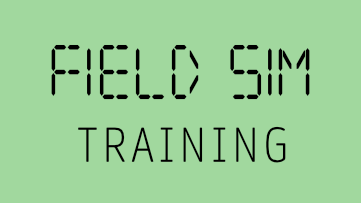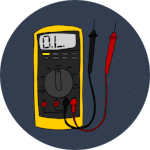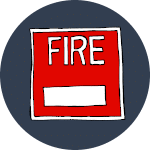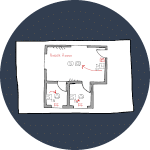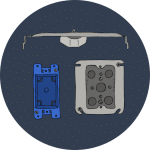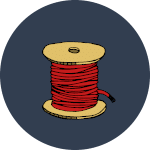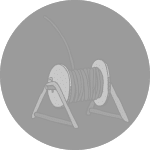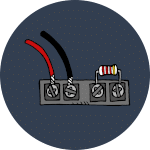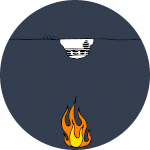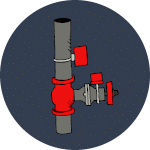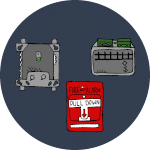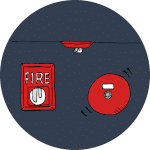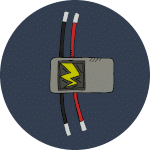Courses
Our training is ideal for electricians, fire alarm technicians, security technicians, helpers, fire department inspectors and anyone else working on low voltage DC controls.
Instructor-Led Training
Troubleshooting and Meter Skills
Quickly diagnosing circuit faults is an essential skill. Learn the principles of electricity and how to apply them to find shorts, opens, grounds, and other circuit faults. Practice hands-on and engage with interactive simulations. More details...
Ensuring Fire Alarm System Compliance
Inspectors need to get up to speed quickly on how to conduct fire alarm inspections. Learn how to test fire alarm components, what code violations to look for, and best practices for conducting a final inspection. More details...
Online On-Demand Training
Introduction to Fire Alarm
Fire alarm systems are complex and require adherence to strict rules. Learn foundational concepts in the fire alarm industry, including how fire alarm systems work and the types of rules that apply. More details...
Tools for Techs
There are hundreds of tools used in the fire alarm industry. Learn to use tools you may never have heard of, including several specialized tools for installing, inspecting and repairing fire alarm systems. More details...
Construction Basics
Installing a fire alarm system or adding to an existing system can be a challenge. Learn the process for installing fire alarm systems and important distinctions between new and remodel construction. More details...
Reading Architectural Drawings
Plans and specifications can seem confusing. They can include critical details not included in the fire alarm set, so it's important to understand them. Learn about many types of drawings and how to use them. More details...
Field Drafting and As-Builts
Documenting a fire alarm system installation is an important code requirement and can help with getting change orders approved. Learn how to create scale drawings by hand and to prepare as-built drawings. More details...
Installing Electrical Boxes
The most common fire alarm installation mistakes are National Electrical Code violations. Learn how to select the correct electrical box and mounting method and how to install it properly. More details...
Intro to Wire
Wire connects initiating devices and notification appliances to fire alarm control units. The rules for fire alarm are stricter than for other trades. Learn about the types of fire alarm wire and when and how to use them. More details...
Terminating Wire
Fire alarm panels and devices use a variety of methods for connecting to wires. Learn to select the right connection type and make a good connection so that the fire alarm system remains operational. More details...
Addressing Devices
There are several ways to assign an address to a fire alarm device. Learn to use decade dials, dip switches, serial numbers and hand-held programmers with examples from EST, Kidde, Simplex and System Sensor. More details...
Installing Smoke and Heat Detectors
Smoke and heat are the primary ways of detecting a fire. Learn how to install smoke and heat detectors properly, how far apart to space them and how to verify that a duct detector is installed correctly. More details...
Installing Sprinkler Devices
Fire sprinklers save lives. Monitoring sprinkler systems is essential for evacuating the building and notifying the fire department. Learn how to set up alarm and supervisory devices on wet, dry and preaction systems. More details...
Installing Modules and Pull Stations
Addressable modules enable you to set up IDCs, NACs and relays far from the control unit using only a pair of wires. Learn how to install these modules, as well as manual pull stations. More details...
Installing Notification Appliances
Speakers, horns and strobes are common fire alarm outputs. Learn proper spacing and installation of these and other notification appliances to ensure building evacuation in case of fire. More details...
Installing Surge Suppressors
Voltage spikes can cause tremendous damage to fire alarm panels and devices. Code requires that you protect fire alarm systems from surges. Learn how to how to properly install various types of surge suppressors. More details...
Free Sample
Not sure if our training is any good? See for yourself how 4k video with real world examples can benefit you. Try our free sample course before you buy. More details...
Get all these courses and save with Fire Alarm 101
Individual courses are only accessible for 30 days. Fire Alarm 101 includes all the courses above for a full year.
Fire Alarm 101 is also a better value, saving you money compared to buying each course individually.
Instructor-Led Options
We're also available to deliver in-person and live online training. Check out our instructor-led offerings.
